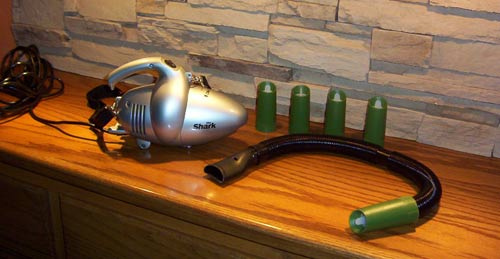dust
sampling
Dust Sampling for Allergens that Cause Asthma and Other Allergic Reactions:
Background: House dust is a complex mixture of particles ranging from
the very large (grains of silica) to the very small (individual bacteria).
Some of the most common house dust components are human skin scales,
animal dander (especially when animals occupy the home), starch particles,
food fragments, soot, a variety of crystalline and amorphous substances
that either come in from outdoors or are applied as cleaning agents,
arthropod parts and excreta, fibers form carpeting, clothing and other
fabrics, fiberglass from insulation, and, of course, fungal spores,
mycelial fragments, yeast cells and bacteria.
The relative concentrations of these different components probably
depend on many factors, although no good studies have been reported
that clearly document these relationships. Some of these possible factors
area:
1. Number and ages of occupants
2. Number and types of pets
3. Housekeeping practices
4. Presence of smokers
5. Use of fireplaces, candles, oil lamps
6. Ventilation type
7. Humidity
8. Water events
9. Characteristics of the surroundings
 House dust is generally dry and easily aerosolized from smooth surfaces.
Vacuuming and other disturbances will release aerosols from furniture,
bedding, carpeting, drapery, etc. Some of the components of house dust
are toxic (e.g., lead, pesticides). Others are allergenic (e.g., dust
mite fecal balls, cockroach excretions, animal dander). Rarely, infectious
agents could be trapped in dust (e.g., anthrax spores during recent
terrorist events).
House dust is generally dry and easily aerosolized from smooth surfaces.
Vacuuming and other disturbances will release aerosols from furniture,
bedding, carpeting, drapery, etc. Some of the components of house dust
are toxic (e.g., lead, pesticides). Others are allergenic (e.g., dust
mite fecal balls, cockroach excretions, animal dander). Rarely, infectious
agents could be trapped in dust (e.g., anthrax spores during recent
terrorist events).
Another reason an environmental investigator might be interested in
house dust is that it may represent past exposures. For example, if
a transient fungal contamination ever occurs, the spores could become
trapped in dust and be recovered even after the event is over.
Interpretation of house dust data depends on why you collected the sample.
Interpreting allergen data is relatively straightforward. Tentative
guidelines have been published that guide interpretation based on the
risk of occupant health effects. Your Allergist (physician) can be instrumental
in identifying what may be causing particular allergic reactions.

Our sampling is fairly straightforward. By using a special collector
attached to a vacuum hose, we need about a thimble's worth to provide
an adequate sample. Problem areas can be targeted...a child's living
environment, for instance. We then ship the sample to EMLab P&K Labs
in Phoenix. They perform the bioassay and provide a list of allergen
concentrations. EMLab P&K is a leader in the laboratory field, promoting
scientific standards to their field testing and have been instrumental
in forming IESO (Indoor Environmental Standards Organization), a nonprofit
group that promotes uniformity in testing, thus bringing consistent
science to the collection and analyses of allergens.
Back to OUR SERVICES

